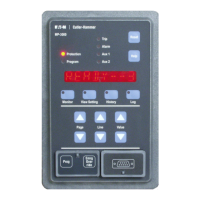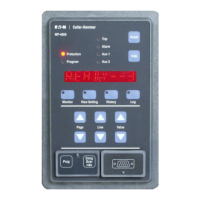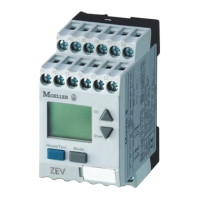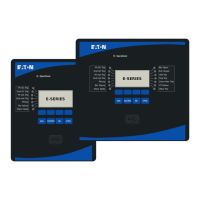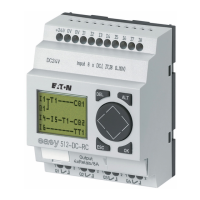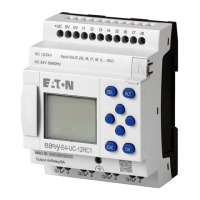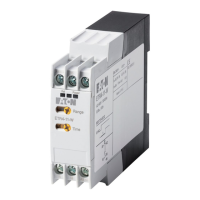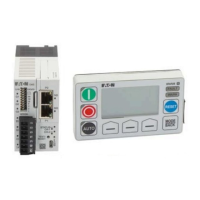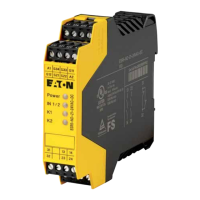Page 5-2
Effective 10/02For more information visit: www.cutler-hammer.eaton.comIL17562BH04
CAUTION
MANY OF THE PROTECTION FUNCTIONS OF THE MP-3000
INCLUDING THE MOTOR THERMAL PROTECTION ALGORITHM,
USE THE FLA SETTING VALUE TO CALCULATE TRIP POINTS. IF
THE USER ENTERS AN INCORRECT SETTING, MANY PROTEC-
TION FUNCTIONS MAY NOT OPERATE AS DESIGNED AND THE
MOTOR MAY BE DAMAGED.
5.1.2 Setting P1L2, Locked-Rotor Current (LRC)
Set to the locked-rotor current (the current the motor draws when
stalled), in percent of FLA (see P1L1). Use motor nameplate or
manufacturer’s data.
5.1.3 Setting P1L3, Maximum Allowable Stall or Locked-Rotor
Time (LRT)
Specifies how long a locked-rotor or stall condition can be maintained
before the motor is damaged, in seconds, for a cold start. Use motor
nameplate or manufacturer’s data.
LRC and LRT combine to specify a point on the motor damage curve
(Figure 9.4) which, when reached during a start, causes a locked-rotor
trip. Refer to subsection 9.1.3 for a detailed explanation.
CAUTION
INCORRECT SETTING VALUES FOR THESE FUNCTIONS CAN RESULT
IN EXCESSIVE ROTOR TEMPERATURES AND MOTOR DAMAGE.
5.1.4 Setting P1L4, Ultimate Trip Current (UTC)
Sets the current level above which a trip will eventually occur when no
RTD stator temperature data is available, in percent of FLA. This value
represents the limit line on the running (upper) portion of the non-RTD
motor damage curve of Figure 9.4.
NOTE: This UTC setting is where the user considers the service factor
rating of the motor. Never adjust the FLA setting P1L1
according to the service factor (see subsection 9.1.3.3).
For normal use, set UTC to service factor times 100%. The available
range is 85% to 150%. The service factor is found on the motor
nameplate or in manufacturer’s data.
Note that the relay will not trip at the moment the current goes above
UTC during motor running. Instead, it models the gradual stator
heating for currents above UTC, and will trip only after some time has
passed. The trip time depends on a variety of setting and operating
factors, including motor nameplate data contained in other setting values.
Use a conservative, or lower, value of UTC than that dictated by the
service factor if motor ambient temperatures may rise above 40ºC and
the optional URTD Module is not used (see Subsection 9.1.1). Also,
consider lowering the UTC if the motor is suitably rated, yet additional
safety is critical for the application.
CAUTION
IF UTC IS SET ABOVE 100 PERCENT TIMES THE SERVICE
FACTOR, MOTOR DAMAGE COULD RESULT.
5.1.5 Setting P1L5, Phase Current Transformer Ratio (PCT)
Specifies the numerator of the turns ratio of the main phase current
transformers. Obtain from the Ct nameplate or from the installation drawings,
watching for the use of ratio taps on Cts which have tapped windings.
Display Complete Help Message
FLA CT L THE RATIO OF FLA TO CT RATIO IS BELOW .25—INCREASE FLA OR DECREASE CT RATIO—PRESS
PROGRAM TO CONTINUE
FLA CT H THE RATIO OF FLA TO CT RATIO IS ABOVE 1.5—DECREASE FLA OR INCREASE CT RATIO—PRESS
PROGRAM TO CONTINUE
IOC OUT IOC SETTING IS OUT OF RANGE—DECREASE IOC OR DECREASE FLA OR INCREASE CT RATIO—PRESS
PROGRAM TO CONTINUE’
JAMT OUT JAM TRIP SETTING IS OUT OF RANGE—DECREASE JAM TRIP OR DECREASE FLA OR INCREASE CT
RATIO—PRESS PROGRAM TO CONTINUE
JAMA OUT JAM ALARM SETTING IS OUT OF RANGE—DECREASE JAM ALARM OR DECREASE FLA OR INCREASE
CT RATIO—PRESS PROGRAM TO CONTINUE
ULT LOW UNDERLOAD TRIP SETTING IS LESS THAN STOP CURRENT LEVEL — DECREASE STOP CURRENT
LEVEL OR INCREASE UNDERLOAD TRIP LEVEL — PRESS PROGRAM TO CONTINUE
ULA LOW UNDERLOAD ALARM SETTING IS LESS THAN STOP CURRENT LEVEL — DECREASE STOP CURRENT
LEVEL OR INCREASE UNDERLOAD ALARM LEVEL — PRESS PROGRAM TO CONTINUE
STP HIGH STOP CURRENT LEVEL IS ABOVE THE START LEVEL — DECREASE STOP CURRENT LEVEL — PRESS
PROGRAM TO CONTINUE
TRNS LOW STOP CURRENT LEVEL IS ABOVE THE TRANSITION LEVEL — DECREASE STOP CURRENT LEVEL OR
INCREASE TRANSITION LEVEL — PRESS PROGRAM TO CONTINUE
Table 5.1 Inconsistent Settings Messages
